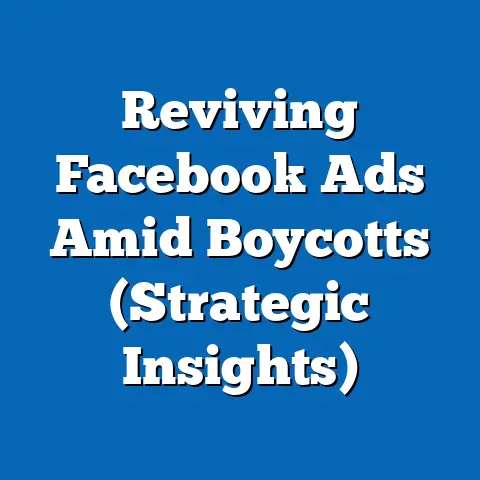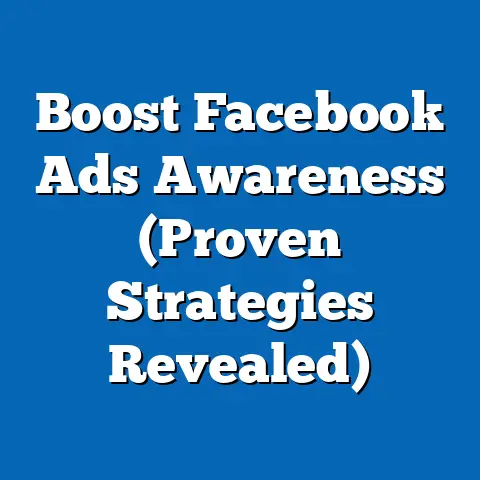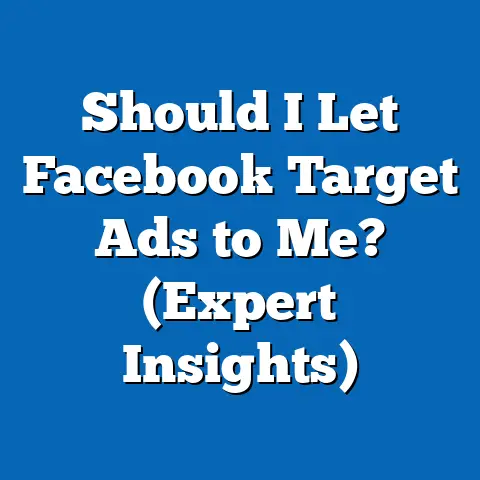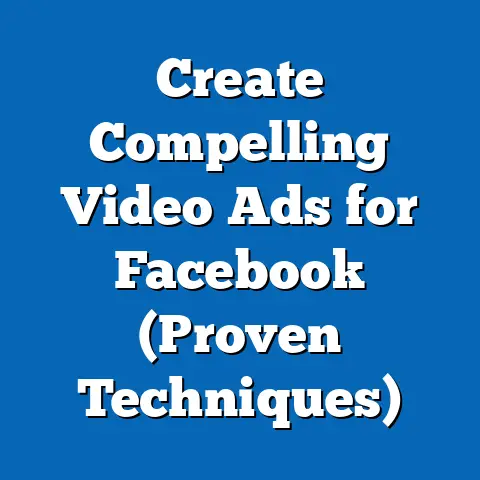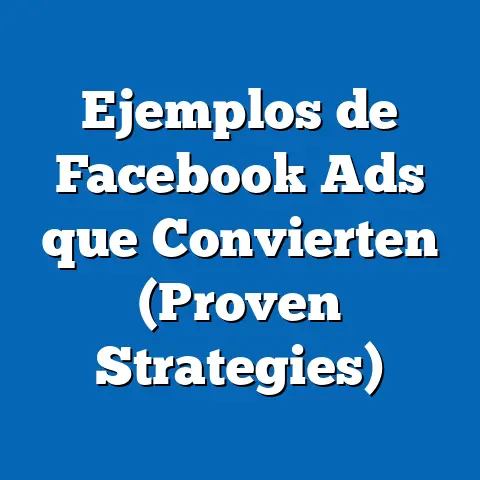Facebook Ad Costs Demystified (Unlock Profitable Strategies)
Imagine a world where your brand shines, captivating audiences with stunning visuals and compelling stories, all while generating substantial profits. That’s the allure of successful Facebook advertising. I’ve seen firsthand how businesses of all sizes, from local boutiques to burgeoning e-commerce giants, have transformed their fortunes through strategic Facebook campaigns. But the key to unlocking this potential lies in understanding the often-intimidating realm of Facebook ad costs.
Think of luxury brands like Chanel or Louis Vuitton. Their Facebook ads aren’t just promotions; they’re curated experiences, meticulously crafted to resonate with their target audience. They understand that every dollar spent must contribute to enhancing brand perception and driving sales. And while their budgets might seem astronomical, the principles they employ – strategic targeting, compelling creative, and continuous optimization – are applicable to businesses of any size.
In this guide, I’m going to demystify Facebook ad costs and reveal the strategies you need to manage and optimize your spending for maximum ROI. I’ll share my experiences, insights, and actionable tips that will empower you to unlock the luxury of effective advertising and achieve the results you’ve always dreamed of. So, buckle up, and let’s dive in!
Understanding Facebook Ad Costs
Navigating the world of Facebook advertising can feel like deciphering a foreign language. Understanding the different cost metrics is crucial to making informed decisions and maximizing your return on investment. Let’s break down the key players:
-
Cost Per Click (CPC): This is the amount you pay each time someone clicks on your ad. It’s a direct measure of how engaging your ad is, and how well it resonates with your target audience. A lower CPC generally indicates that your ad is highly relevant and compelling.
-
Cost Per Mille (CPM): “Mille” is Latin for thousand. CPM represents the cost you pay for every 1,000 impressions your ad receives. An impression is simply when your ad is shown to a user, regardless of whether they click on it or not. CPM is a useful metric for measuring brand awareness and reach.
-
Cost Per Action (CPA): This metric measures the cost of acquiring a specific action, such as a purchase, a lead, or a registration. CPA is directly tied to your campaign objectives and is a critical indicator of your campaign’s profitability.
Cost Per Click (CPC): This is the amount you pay each time someone clicks on your ad. It’s a direct measure of how engaging your ad is, and how well it resonates with your target audience. A lower CPC generally indicates that your ad is highly relevant and compelling.
Cost Per Mille (CPM): “Mille” is Latin for thousand. CPM represents the cost you pay for every 1,000 impressions your ad receives. An impression is simply when your ad is shown to a user, regardless of whether they click on it or not. CPM is a useful metric for measuring brand awareness and reach.
Cost Per Action (CPA): This metric measures the cost of acquiring a specific action, such as a purchase, a lead, or a registration. CPA is directly tied to your campaign objectives and is a critical indicator of your campaign’s profitability.
These costs aren’t static; they fluctuate based on a myriad of factors. Think of it like the stock market – constantly changing in response to supply, demand, and external influences. Let’s consider some real-world examples:
-
Industry Variations: I’ve observed that highly competitive industries like finance and insurance often have higher CPCs and CPAs due to the increased demand for ad space and the higher value placed on acquiring a customer. Conversely, niche markets with less competition may enjoy lower costs.
-
Audience Targeting: A broad audience targeting strategy might result in a lower CPM, but it could also lead to a higher CPC and CPA if the ad isn’t highly relevant to the viewers. Narrowing your audience to a more specific demographic or interest group can increase relevance and improve overall performance.
-
Ad Placement: The placement of your ad – whether it’s in the Facebook newsfeed, Instagram Stories, or the Audience Network – can significantly impact costs. I’ve found that placements with higher visibility and engagement, like the Facebook newsfeed, often command higher CPMs.
Industry Variations: I’ve observed that highly competitive industries like finance and insurance often have higher CPCs and CPAs due to the increased demand for ad space and the higher value placed on acquiring a customer. Conversely, niche markets with less competition may enjoy lower costs.
Audience Targeting: A broad audience targeting strategy might result in a lower CPM, but it could also lead to a higher CPC and CPA if the ad isn’t highly relevant to the viewers. Narrowing your audience to a more specific demographic or interest group can increase relevance and improve overall performance.
Ad Placement: The placement of your ad – whether it’s in the Facebook newsfeed, Instagram Stories, or the Audience Network – can significantly impact costs. I’ve found that placements with higher visibility and engagement, like the Facebook newsfeed, often command higher CPMs.
To illustrate the impact of these costs on ROI, let’s consider a hypothetical scenario:
Imagine two businesses, both running Facebook ad campaigns with a budget of $1,000.
-
Business A: Achieves a CPC of $1.00 and a CPA of $20. This means they get 1,000 clicks and 50 conversions (e.g., sales).
-
Business B: Achieves a CPC of $0.50 and a CPA of $10. This means they get 2,000 clicks and 100 conversions.
Business A: Achieves a CPC of $1.00 and a CPA of $20. This means they get 1,000 clicks and 50 conversions (e.g., sales).
Business B: Achieves a CPC of $0.50 and a CPA of $10. This means they get 2,000 clicks and 100 conversions.
Even with the same budget, Business B generates twice as many conversions due to their lower costs. This highlights the importance of understanding and optimizing these metrics to maximize your ROI.
Key Takeaway: Understanding the different components of Facebook ad costs (CPC, CPM, CPA) and how they fluctuate is the foundation for building a profitable advertising strategy. The next step is to identify the factors that influence these costs and learn how to leverage them to your advantage.
Factors Influencing Facebook Ad Costs
Now that we’ve defined the key cost metrics, let’s delve into the factors that influence them. Think of Facebook’s ad auction like a complex ecosystem, where various elements interact to determine the final price you pay. Understanding these elements is crucial for navigating the system effectively.
-
Audience Targeting: This is arguably one of the most significant factors influencing ad costs. The more specific and targeted your audience, the higher the potential for relevance, and the lower your costs can be. I’ve seen this play out time and again. For example, targeting a broad audience with a generic interest like “travel” will likely result in higher costs and lower engagement compared to targeting a specific group interested in “luxury adventure travel in Southeast Asia.”
- Demographics: Age, gender, location, education level, and job title are all demographic factors that can influence costs.
- Interests: Targeting users based on their interests can be effective, but it’s important to refine your targeting to avoid broad, generic interests that attract a wide range of users.
- Behaviors: Facebook tracks user behaviors, such as purchase history, website visits, and app usage, which can be used to create highly targeted audiences.
-
Ad Quality: Facebook’s ad relevance score is a crucial indicator of ad quality. This score is based on how relevant and engaging your ad is to your target audience. A higher relevance score can lead to lower costs and better ad delivery. I’ve personally experienced the positive impact of improving ad quality. By refining ad copy, using high-quality visuals, and ensuring a clear call-to-action, I’ve consistently seen my relevance scores increase and my costs decrease.
-
Bidding Strategies: Facebook offers a range of bidding strategies, from automated bidding to manual bidding.
- Automated Bidding: This allows Facebook to automatically adjust your bids to achieve your desired results, such as maximizing conversions or reach. While convenient, it’s important to monitor performance and ensure that Facebook is optimizing effectively.
- Manual Bidding: This gives you more control over your bids, allowing you to set a maximum bid for each click or impression. This can be useful for controlling costs, but it requires more active management and a deeper understanding of the ad auction.
-
Seasonal Trends: Demand for ad space fluctuates throughout the year, with certain periods, like the holiday season, experiencing a surge in competition and higher costs. I’ve learned to plan my campaigns accordingly, adjusting budgets and targeting strategies to account for these seasonal trends. For example, I often advise clients to start their holiday campaigns earlier than they think necessary to secure ad space and avoid the last-minute rush.
Audience Targeting: This is arguably one of the most significant factors influencing ad costs. The more specific and targeted your audience, the higher the potential for relevance, and the lower your costs can be. I’ve seen this play out time and again. For example, targeting a broad audience with a generic interest like “travel” will likely result in higher costs and lower engagement compared to targeting a specific group interested in “luxury adventure travel in Southeast Asia.”
- Demographics: Age, gender, location, education level, and job title are all demographic factors that can influence costs.
- Interests: Targeting users based on their interests can be effective, but it’s important to refine your targeting to avoid broad, generic interests that attract a wide range of users.
- Behaviors: Facebook tracks user behaviors, such as purchase history, website visits, and app usage, which can be used to create highly targeted audiences.
Ad Quality: Facebook’s ad relevance score is a crucial indicator of ad quality. This score is based on how relevant and engaging your ad is to your target audience. A higher relevance score can lead to lower costs and better ad delivery. I’ve personally experienced the positive impact of improving ad quality. By refining ad copy, using high-quality visuals, and ensuring a clear call-to-action, I’ve consistently seen my relevance scores increase and my costs decrease.
Bidding Strategies: Facebook offers a range of bidding strategies, from automated bidding to manual bidding.
- Automated Bidding: This allows Facebook to automatically adjust your bids to achieve your desired results, such as maximizing conversions or reach. While convenient, it’s important to monitor performance and ensure that Facebook is optimizing effectively.
- Manual Bidding: This gives you more control over your bids, allowing you to set a maximum bid for each click or impression. This can be useful for controlling costs, but it requires more active management and a deeper understanding of the ad auction.
Seasonal Trends: Demand for ad space fluctuates throughout the year, with certain periods, like the holiday season, experiencing a surge in competition and higher costs. I’ve learned to plan my campaigns accordingly, adjusting budgets and targeting strategies to account for these seasonal trends. For example, I often advise clients to start their holiday campaigns earlier than they think necessary to secure ad space and avoid the last-minute rush.
To illustrate the impact of these factors, let’s look at a hypothetical case study:
Company X, a small e-commerce business selling handmade jewelry, initially ran a broad Facebook ad campaign targeting women aged 25-55 with an interest in “jewelry.” Their CPC was $1.50, and their CPA was $30.
After analyzing their data, they realized that their most successful customers were women aged 30-45 with an interest in “handmade jewelry” and “ethical fashion.” They refined their targeting and improved their ad quality by using high-quality images of their jewelry and crafting compelling ad copy that highlighted the unique craftsmanship and ethical sourcing of their products.
As a result, their CPC dropped to $0.75, and their CPA decreased to $15. By understanding and addressing the factors influencing their ad costs, Company X significantly improved their ROI.
Key Takeaway: Understanding the factors that influence Facebook ad costs – audience targeting, ad quality, bidding strategies, and seasonal trends – is crucial for optimizing your campaigns and maximizing your ROI. The next step is to implement actionable strategies to leverage these factors to your advantage.
Strategies to Optimize Facebook Ad Spending
Now that we understand the key cost metrics and the factors that influence them, let’s dive into actionable strategies for optimizing your Facebook ad spending and maximizing your ROI. Think of these strategies as tools in your toolbox, each designed to address specific challenges and improve your overall performance.
-
A/B Testing: This is the cornerstone of any successful Facebook advertising strategy. It involves testing different variations of your ads – including ad creatives, ad copy, and audience targeting – to identify what resonates best with your target audience. I can’t stress enough how important this is. I always tell my clients, “Never assume, always test!”
- Ad Creatives: Test different images, videos, and ad formats to see which ones generate the highest engagement and conversion rates.
- Ad Copy: Experiment with different headlines, descriptions, and calls-to-action to find the most compelling messaging.
- Audience Targeting: Test different demographic, interest-based, and behavioral targeting options to identify the most responsive audience segments.
The key to effective A/B testing is to only change one variable at a time. This allows you to isolate the impact of each change and accurately determine what’s driving performance.
-
Retargeting: This strategy involves targeting users who have previously interacted with your website or brand. Retargeting is incredibly powerful because it allows you to reach users who are already familiar with your brand and are more likely to convert. I’ve seen retargeting campaigns consistently outperform other types of campaigns, often generating significantly higher conversion rates and lower CPAs.
- Website Visitors: Target users who have visited specific pages on your website.
- Email Subscribers: Upload your email list to Facebook and target your subscribers with relevant ads.
- Video Viewers: Target users who have watched a certain percentage of your videos.
-
Audience Segmentation: This involves dividing your target audience into smaller, more specific segments based on demographics, interests, behaviors, and other factors. Tailoring your ads to these specific segments can significantly improve engagement and lower costs. I’ve found that this is particularly effective for businesses with a diverse customer base.
- Demographic Segmentation: Segment your audience based on age, gender, location, and other demographic factors.
- Interest-Based Segmentation: Segment your audience based on their interests and hobbies.
- Behavioral Segmentation: Segment your audience based on their online behaviors, such as purchase history and website activity.
-
Utilizing Lookalike Audiences: This is a powerful tool for expanding your reach and finding new customers who are similar to your existing ones. Facebook uses its vast database to identify users who share similar characteristics with your best customers, allowing you to target a highly relevant audience without having to manually define all the targeting criteria.
- Customer List Lookalike: Create a lookalike audience based on your existing customer list.
- Website Visitor Lookalike: Create a lookalike audience based on users who have visited your website.
- Page Engager Lookalike: Create a lookalike audience based on users who have engaged with your Facebook page.
A/B Testing: This is the cornerstone of any successful Facebook advertising strategy. It involves testing different variations of your ads – including ad creatives, ad copy, and audience targeting – to identify what resonates best with your target audience. I can’t stress enough how important this is. I always tell my clients, “Never assume, always test!”
- Ad Creatives: Test different images, videos, and ad formats to see which ones generate the highest engagement and conversion rates.
- Ad Copy: Experiment with different headlines, descriptions, and calls-to-action to find the most compelling messaging.
- Audience Targeting: Test different demographic, interest-based, and behavioral targeting options to identify the most responsive audience segments.
The key to effective A/B testing is to only change one variable at a time. This allows you to isolate the impact of each change and accurately determine what’s driving performance.
Retargeting: This strategy involves targeting users who have previously interacted with your website or brand. Retargeting is incredibly powerful because it allows you to reach users who are already familiar with your brand and are more likely to convert. I’ve seen retargeting campaigns consistently outperform other types of campaigns, often generating significantly higher conversion rates and lower CPAs.
- Website Visitors: Target users who have visited specific pages on your website.
- Email Subscribers: Upload your email list to Facebook and target your subscribers with relevant ads.
- Video Viewers: Target users who have watched a certain percentage of your videos.
Audience Segmentation: This involves dividing your target audience into smaller, more specific segments based on demographics, interests, behaviors, and other factors. Tailoring your ads to these specific segments can significantly improve engagement and lower costs. I’ve found that this is particularly effective for businesses with a diverse customer base.
- Demographic Segmentation: Segment your audience based on age, gender, location, and other demographic factors.
- Interest-Based Segmentation: Segment your audience based on their interests and hobbies.
- Behavioral Segmentation: Segment your audience based on their online behaviors, such as purchase history and website activity.
Utilizing Lookalike Audiences: This is a powerful tool for expanding your reach and finding new customers who are similar to your existing ones. Facebook uses its vast database to identify users who share similar characteristics with your best customers, allowing you to target a highly relevant audience without having to manually define all the targeting criteria.
- Customer List Lookalike: Create a lookalike audience based on your existing customer list.
- Website Visitor Lookalike: Create a lookalike audience based on users who have visited your website.
- Page Engager Lookalike: Create a lookalike audience based on users who have engaged with your Facebook page.
In addition to these core strategies, here are some additional tips for optimizing your Facebook ad spending:
- Set Realistic Budgets: Don’t overspend on your initial campaigns. Start with a small budget and gradually increase it as you see positive results.
- Monitor Ad Performance: Regularly monitor your ad performance and make adjustments as needed. Pay attention to key metrics like CPC, CPM, CPA, and conversion rates.
- Data-Driven Decisions: Base your decisions on data, not gut feelings. Use the insights you gather from your ad performance to refine your targeting, ad creatives, and bidding strategies.
Key Takeaway: By implementing these strategies – A/B testing, retargeting, audience segmentation, and utilizing lookalike audiences – you can significantly optimize your Facebook ad spending and maximize your ROI. The next step is to create compelling ad content that resonates with your audience and drives conversions.
Unlocking Profitable Facebook Ad Campaigns
Creating compelling ad content is the heart of any successful Facebook advertising strategy. It’s not just about showcasing your product or service; it’s about telling a story that resonates with your audience and inspires them to take action. Think of your ads as mini-movies, each designed to capture attention, build trust, and drive conversions.
-
The Power of Storytelling: In today’s crowded digital landscape, storytelling is more important than ever. People are bombarded with ads every day, so you need to find a way to stand out from the noise. Storytelling allows you to connect with your audience on an emotional level, building a deeper connection and fostering brand loyalty.
- Luxury Brands: Luxury brands have mastered the art of storytelling. Their Facebook ads often feature stunning visuals, evocative music, and compelling narratives that transport viewers to a world of elegance and sophistication. They’re not just selling a product; they’re selling a lifestyle.
- Non-Luxury Brands: Even non-luxury brands can benefit from storytelling. Share customer testimonials, highlight the unique benefits of your product or service, or create a behind-the-scenes video that showcases your company’s values and culture.
-
Examples of Successful Facebook Ad Campaigns: Let’s examine some examples of successful Facebook ad campaigns from both luxury and non-luxury brands:
- Luxury Brand – Chanel: Chanel’s Facebook ads often feature short films showcasing their latest collections, starring renowned actresses and models. The visuals are stunning, the music is captivating, and the narrative is carefully crafted to enhance the brand’s image of luxury and sophistication.
- Non-Luxury Brand – Dollar Shave Club: Dollar Shave Club built its brand on humor and irreverence. Their Facebook ads often feature witty videos that poke fun at the shaving industry and highlight the affordability and convenience of their subscription service.
-
Aligning Ad Objectives with Business Goals: It’s crucial to align your ad objectives with your overall business goals. What are you trying to achieve with your Facebook advertising campaigns? Are you trying to increase brand awareness, generate leads, or drive sales?
- Brand Awareness: If your goal is to increase brand awareness, focus on reaching a large audience with engaging content that showcases your brand’s values and personality.
- Lead Generation: If your goal is to generate leads, focus on creating compelling offers and landing pages that encourage users to provide their contact information.
- Sales: If your goal is to drive sales, focus on showcasing your products or services with high-quality images and videos, and include a clear call-to-action that encourages users to purchase.
The Power of Storytelling: In today’s crowded digital landscape, storytelling is more important than ever. People are bombarded with ads every day, so you need to find a way to stand out from the noise. Storytelling allows you to connect with your audience on an emotional level, building a deeper connection and fostering brand loyalty.
- Luxury Brands: Luxury brands have mastered the art of storytelling. Their Facebook ads often feature stunning visuals, evocative music, and compelling narratives that transport viewers to a world of elegance and sophistication. They’re not just selling a product; they’re selling a lifestyle.
- Non-Luxury Brands: Even non-luxury brands can benefit from storytelling. Share customer testimonials, highlight the unique benefits of your product or service, or create a behind-the-scenes video that showcases your company’s values and culture.
Examples of Successful Facebook Ad Campaigns: Let’s examine some examples of successful Facebook ad campaigns from both luxury and non-luxury brands:
- Luxury Brand – Chanel: Chanel’s Facebook ads often feature short films showcasing their latest collections, starring renowned actresses and models. The visuals are stunning, the music is captivating, and the narrative is carefully crafted to enhance the brand’s image of luxury and sophistication.
- Non-Luxury Brand – Dollar Shave Club: Dollar Shave Club built its brand on humor and irreverence. Their Facebook ads often feature witty videos that poke fun at the shaving industry and highlight the affordability and convenience of their subscription service.
Aligning Ad Objectives with Business Goals: It’s crucial to align your ad objectives with your overall business goals. What are you trying to achieve with your Facebook advertising campaigns? Are you trying to increase brand awareness, generate leads, or drive sales?
- Brand Awareness: If your goal is to increase brand awareness, focus on reaching a large audience with engaging content that showcases your brand’s values and personality.
- Lead Generation: If your goal is to generate leads, focus on creating compelling offers and landing pages that encourage users to provide their contact information.
- Sales: If your goal is to drive sales, focus on showcasing your products or services with high-quality images and videos, and include a clear call-to-action that encourages users to purchase.
Key Takeaway: Creating compelling ad content that resonates with your audience and drives conversions is essential for unlocking profitable Facebook ad campaigns. By leveraging the power of storytelling, studying successful campaigns, and aligning your ad objectives with your business goals, you can create ads that capture attention, build trust, and generate results.
Measuring Success and Adapting Strategies
The final piece of the puzzle is measuring your success and adapting your strategies based on your results. Think of Facebook advertising as an ongoing experiment, where you’re constantly testing, learning, and refining your approach.
-
Key Performance Indicators (KPIs): Monitoring the right KPIs is crucial for measuring the success of your Facebook ad campaigns. Here are some of the most important KPIs to track:
- Reach: The number of unique users who saw your ad.
- Impressions: The number of times your ad was displayed.
- Clicks: The number of times users clicked on your ad.
- Click-Through Rate (CTR): The percentage of users who saw your ad and clicked on it.
- Cost Per Click (CPC): The amount you paid for each click.
- Cost Per Mille (CPM): The amount you paid for every 1,000 impressions.
- Conversions: The number of users who completed a desired action, such as a purchase or a lead submission.
- Cost Per Acquisition (CPA): The amount you paid for each conversion.
- Return on Ad Spend (ROAS): The revenue you generated for every dollar you spent on advertising.
-
Interpreting Data from Facebook Ads Manager: Facebook Ads Manager provides a wealth of data about your ad performance. Learning how to interpret this data is crucial for making informed decisions about your campaigns.
- Identify Trends: Look for trends in your data to identify what’s working and what’s not. Are certain ad creatives performing better than others? Are certain audience segments more responsive than others?
- Analyze Demographics: Analyze the demographics of your audience to identify who’s engaging with your ads and who’s not. This can help you refine your targeting and create more relevant ads.
- Track Conversions: Track your conversions to see which ads are driving the most sales or leads. This can help you allocate your budget more effectively.
-
Continuous Learning and Adaptation: The digital landscape is constantly evolving, so it’s important to stay up-to-date on the latest trends and best practices in Facebook advertising. Attend industry conferences, read blogs and articles, and experiment with new features and strategies.
Key Performance Indicators (KPIs): Monitoring the right KPIs is crucial for measuring the success of your Facebook ad campaigns. Here are some of the most important KPIs to track:
- Reach: The number of unique users who saw your ad.
- Impressions: The number of times your ad was displayed.
- Clicks: The number of times users clicked on your ad.
- Click-Through Rate (CTR): The percentage of users who saw your ad and clicked on it.
- Cost Per Click (CPC): The amount you paid for each click.
- Cost Per Mille (CPM): The amount you paid for every 1,000 impressions.
- Conversions: The number of users who completed a desired action, such as a purchase or a lead submission.
- Cost Per Acquisition (CPA): The amount you paid for each conversion.
- Return on Ad Spend (ROAS): The revenue you generated for every dollar you spent on advertising.
Interpreting Data from Facebook Ads Manager: Facebook Ads Manager provides a wealth of data about your ad performance. Learning how to interpret this data is crucial for making informed decisions about your campaigns.
- Identify Trends: Look for trends in your data to identify what’s working and what’s not. Are certain ad creatives performing better than others? Are certain audience segments more responsive than others?
- Analyze Demographics: Analyze the demographics of your audience to identify who’s engaging with your ads and who’s not. This can help you refine your targeting and create more relevant ads.
- Track Conversions: Track your conversions to see which ads are driving the most sales or leads. This can help you allocate your budget more effectively.
Continuous Learning and Adaptation: The digital landscape is constantly evolving, so it’s important to stay up-to-date on the latest trends and best practices in Facebook advertising. Attend industry conferences, read blogs and articles, and experiment with new features and strategies.
Key Takeaway: Measuring your success and adapting your strategies based on your results is essential for maximizing your ROI. By monitoring the right KPIs, interpreting data from Facebook Ads Manager, and continuously learning and adapting, you can stay ahead of the competition and achieve your advertising goals.
Conclusion
Understanding Facebook ad costs is not just about saving money; it’s about unlocking the luxury of effective advertising. It’s about transforming your brand into a captivating force that resonates with your audience and drives meaningful results.
I’ve shared my personal experiences, insights, and actionable tips to empower you to navigate the complexities of Facebook advertising and achieve the results you’ve always dreamed of. Remember, the path to success is attainable with the right knowledge and execution.
Embrace the luxury of effective advertising by applying the strategies discussed in this guide. Test different ad creatives, refine your targeting, and continuously monitor your performance. The journey may not always be easy, but the rewards – enhanced brand visibility, increased sales, and a thriving business – are well worth the effort. Now go out there and create some magic!

